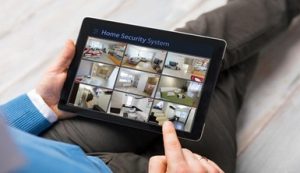
Residential burglaries and break-ins are a problem for many homeowners. The FBI estimates there were approximately 1,117,696 burglaries in 2019 in the United States, which accounted for 16.1% of property crimes. Having proper home security can not only protect your home and belongings, but it can also keep your family safe.
Even if you’re new to the idea of having and using smart home security devices, it’s easy to get started. This guide will provide the information and actionable tips you need to get started with your home security system.
When you have a home security system, you’re able to detect a possible intrusion into your home, even when you’re not there. This detection system may help protect you, your family, and your property from various crimes, including home invasions. Property crime and theft cost Americans billions of dollars each year.
Installing and using a home security system can prevent you from becoming a victim. Some homeowner insurance companies also offer customers a discount for installing a security system. Not only will you feel safer and more protected, but you could also save money in the long run.
Having the right home security keeps you safe, and it’ll also cause criminals to think twice before entering your home. Using the right equipment can prevent these crimes from happening to you in the first place. It’s vital to ensure that you’re using multi-layered security, including alarms, intrusion detection, cameras, and more.
New smart security technology makes it easier than ever to monitor your home from almost anywhere in the world. The more barriers you can put in place between your home and potential criminals, the safer you and your family will be.
Every home security system needs some fundamental pieces of equipment in order to be effective. Here are the most important items you’ll need to get started:
• Intrusion detection: This equipment includes the main security panel that allows you to control the system. It can be called the keypad, control panel, or security hub. The panel allows you to make changes or arm and disarm the system as needed. Door and window sensors alert you when someone tries to enter your home, as well as motion sensors that detect any unusual movement. Glass break sensors are another great piece of equipment, they recognise breaking glass, which signals the alarm if someone tries to break a window.
• Lighting: Even something as simple as bright exterior lighting can keep your home safer. Consider upgrading your outdoor lighting to motion-sensing lights that turn on whenever they detect movement. Add this lighting to the corners of your home, near the garage, and at the front and back doors.
• Cameras: Security cameras record activity in and around your home. Choose a PTZ or pan-tilt-zoom camera so you can move the camera, zoom in, and adjust it remotely for better footage. Use cameras that store the footage just in case you need to view it or show it to the police later. Some cameras include built-in memory cards, while others require payment for storage on a cloud network. A camera doorbell is another great way to keep you safe. It alerts you and records video when someone approaches your home.
• Monitoring: If you travel or you’re away from home frequently, enrolling in home security monitoring is a great way to protect your property. It requires a monthly fee, but this service connects to your system and keeps a watchful eye over your home when you’re not there. The authorities and you will be immediately alerted if an alarm goes off or fire is detected. This is a great way to get peace of mind whenever you’re not at home.
If you’re unfamiliar with how to install any of your new pieces of security equipment, a professional installer can help. They have the skills and experience required to ensure that every piece of equipment is correctly installed and connected for the best coverage to keep you safe.
Once you have your new smart home security system installed, you’ll need to protect it from hackers. Most Wi-Fi routers aren’t immediately secure upon installation until you change the password. Make sure you’re using a strong password containing a unique mixture of letters, numbers, and symbols. Integrating capital letters will also make it more difficult for hackers to access them. The longer and more complex your password is, the less likely your network will be hacked by nefarious outsiders.
It’s also crucial to ensure that your Wi-Fi network and equipment come from a trusted, reputable manufacturer with a long history of providing security to its customers. You should also double-check to see how the manufacturer uses the information it collects and if it’s being given to third parties for marketing or other purposes.
The term multi-factor authentication refers to the several pieces of information required from a user to access an account. This access method is put in place to protect yourself from possible breaches and verify your identity. This option is usually available with the majority of newer smart home security systems and collects more than just a password.
Using multi-factor authentication may require you to scan your fingerprint or retina to ensure it’s really you trying to access the system. It may also ask for things like a numeric passcode or have you answer a security question. If this option is available to you, it’s highly recommended that you set it up. This simple additional step will help to prevent cybercriminals from trying to use your user credentials and access your profile. It’s also a great way to protect yourself from potential data breaches.
Just like your smartphone or computer, your smart home security devices should be updated regularly. These new updates provide improvements to the usability of your equipment, better protection against hackers, and new hardware updates that help the equipment run smoother.
Some devices will alert you when an update is available, and others won’t. Set a reminder to check the manufacturer’s website every month or so to confirm there are new updates ready. You should also pair your mobile app to your security devices and adjust the settings to turn on automatic software updates so you never miss anything. This is the best way to ensure you have all of the latest hardware upgrades and security patches.
Use these important tips if you’re just beginning the process of installing a home security system. With the right equipment and proper protections in place, you can keep your home and family safe. Remember to install the most essential equipment, use unique passwords, and take steps to ensure that your new software and equipment are as secure as possible for peace of mind.











